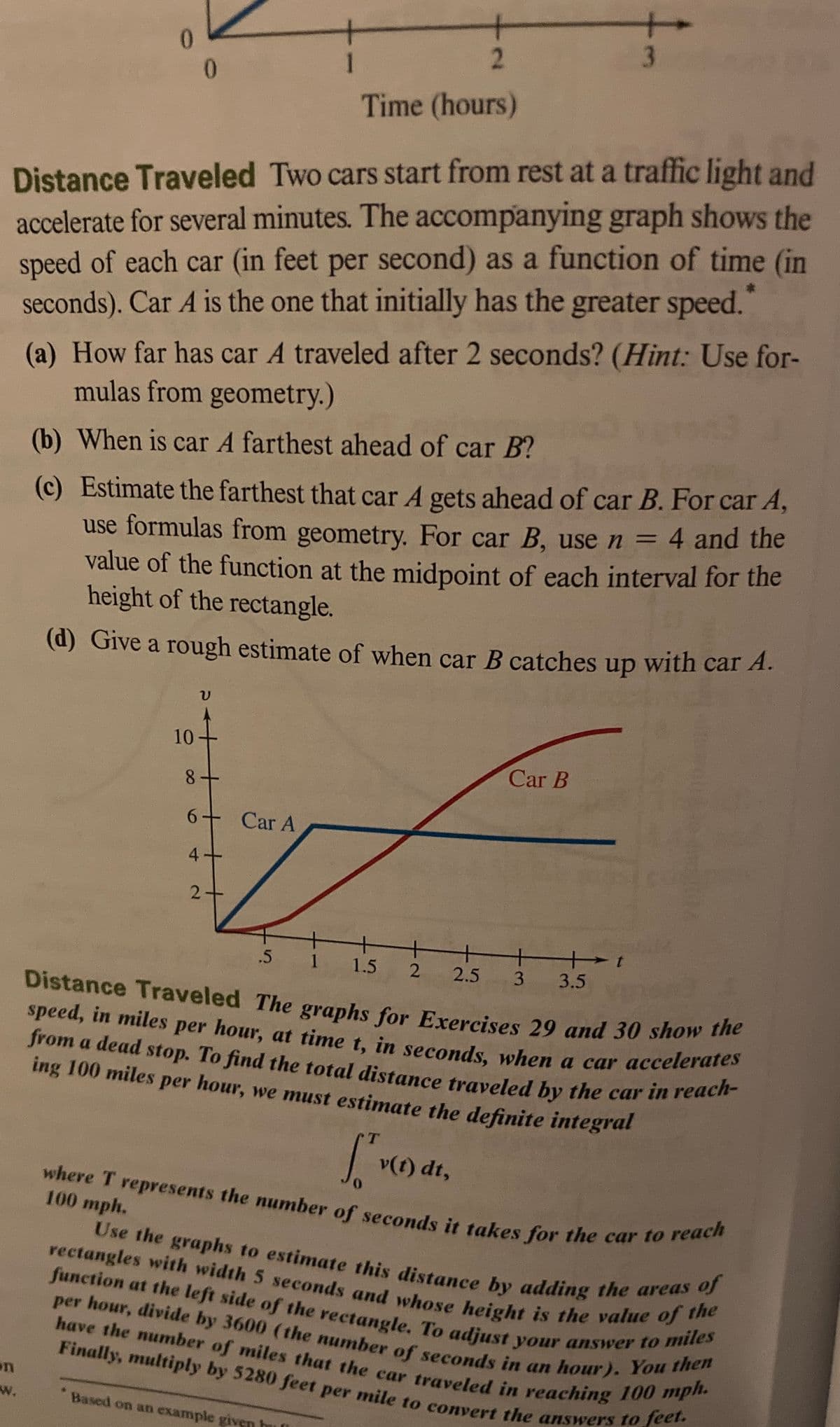Distance Traveled Two cars start from rest at a traffic light and accelerate for several minutes. The accompanying graph shows the speed of each car (in feet per second) as a function of time (in seconds). Car A is the one that initially has the greater speed." (a) How far has car A traveled after 2 seconds? (Hint: Use for- mulas from geometry.) (b) When is car A farthest ahead of car B? (c) Estimate the farthest that car A gets ahead of car B. For car A, use formulas from geometry. For car B, use n value of the function at the midpoint of each interval for the height of the rectangle. 4 and the (d) Give a rough estimate of when car B catches up with car A. 10 Car B 8+ 6+ Car A 4+ 2+ .5 1.5 2.5 3 3.5 Distance Traveled Tha
Distance Traveled Two cars start from rest at a traffic light and accelerate for several minutes. The accompanying graph shows the speed of each car (in feet per second) as a function of time (in seconds). Car A is the one that initially has the greater speed." (a) How far has car A traveled after 2 seconds? (Hint: Use for- mulas from geometry.) (b) When is car A farthest ahead of car B? (c) Estimate the farthest that car A gets ahead of car B. For car A, use formulas from geometry. For car B, use n value of the function at the midpoint of each interval for the height of the rectangle. 4 and the (d) Give a rough estimate of when car B catches up with car A. 10 Car B 8+ 6+ Car A 4+ 2+ .5 1.5 2.5 3 3.5 Distance Traveled Tha
Glencoe Algebra 1, Student Edition, 9780079039897, 0079039898, 2018
18th Edition
ISBN:9780079039897
Author:Carter
Publisher:Carter
Chapter1: Expressions And Functions
Section1.8: Interpreting Graphs Of Functions
Problem 4CYU
Related questions
Question

Transcribed Image Text:speed, in miles per hour, at time t, in seconds, when a car accelerates
from a dead stop. To find the total distance traveled by the car in reach-
Finally, multiply by 5280 feet per mile to convert the answers to feet.
have the number of miles that the car traveled in reaching 100 mph.
Use the graphs to estimate this distance by adding the areas of
per hour, divide by 3600 (the number of seconds in an hour). You then
function at the left side of the rectangle. To adjust your answer to miles
rectangles with width 5 seconds and whose height is the value of the
where T represents the number of seconds it takes for the car to reach
3
0.
Time (hours)
Distance Traveled Two cars start from rest at a traffic light and
accelerate for several minutes. The accompanying graph shows the
speed of each car (in feet per second) as a function of time (in
seconds). Car A is the one that initially has the greater speed."
(a) How far has car A traveled after 2 seconds? (Hint: Use for-
mulas from geometry.)
(b) When is car A farthest ahead of car B?
(c) Estimate the farthest that car A gets ahead of car B. For car A,
use formulas from geometry. For car B, use n =
value of the function at the midpoint of each interval for the
height of the rectangle.
4 and the
(d) Give a rough estimate of when car B catches up with car A.
10
Car B
8+
6 Car A
4.
+
1.5
.5
2.5 3
3.5
Distance Traveled The graphs for Exercises 29 and 30 show he
speed, in miles per hour, at time t, in seconds, when a car accelerates
from a dead stop. To find the total distance traveled by the car in reuen
ing 100 miles per hour, we must estimate the definite integral
v(t) dt,
0.
100 mph.
Use the graphs to estimate this distamce by adding the areuhe
function at the left side of the rectangle To adiust vour answer dhen
per
Finally, multiply by 5280 feet per mile to convert the answers
on
w.
* Based on an example giv
is
Expert Solution
This question has been solved!
Explore an expertly crafted, step-by-step solution for a thorough understanding of key concepts.
This is a popular solution!
Trending now
This is a popular solution!
Step by step
Solved in 3 steps

Knowledge Booster
Learn more about
Need a deep-dive on the concept behind this application? Look no further. Learn more about this topic, calculus and related others by exploring similar questions and additional content below.Recommended textbooks for you

Glencoe Algebra 1, Student Edition, 9780079039897…
Algebra
ISBN:
9780079039897
Author:
Carter
Publisher:
McGraw Hill

Algebra: Structure And Method, Book 1
Algebra
ISBN:
9780395977224
Author:
Richard G. Brown, Mary P. Dolciani, Robert H. Sorgenfrey, William L. Cole
Publisher:
McDougal Littell

Functions and Change: A Modeling Approach to Coll…
Algebra
ISBN:
9781337111348
Author:
Bruce Crauder, Benny Evans, Alan Noell
Publisher:
Cengage Learning

Glencoe Algebra 1, Student Edition, 9780079039897…
Algebra
ISBN:
9780079039897
Author:
Carter
Publisher:
McGraw Hill

Algebra: Structure And Method, Book 1
Algebra
ISBN:
9780395977224
Author:
Richard G. Brown, Mary P. Dolciani, Robert H. Sorgenfrey, William L. Cole
Publisher:
McDougal Littell

Functions and Change: A Modeling Approach to Coll…
Algebra
ISBN:
9781337111348
Author:
Bruce Crauder, Benny Evans, Alan Noell
Publisher:
Cengage Learning

Holt Mcdougal Larson Pre-algebra: Student Edition…
Algebra
ISBN:
9780547587776
Author:
HOLT MCDOUGAL
Publisher:
HOLT MCDOUGAL

College Algebra
Algebra
ISBN:
9781305115545
Author:
James Stewart, Lothar Redlin, Saleem Watson
Publisher:
Cengage Learning
